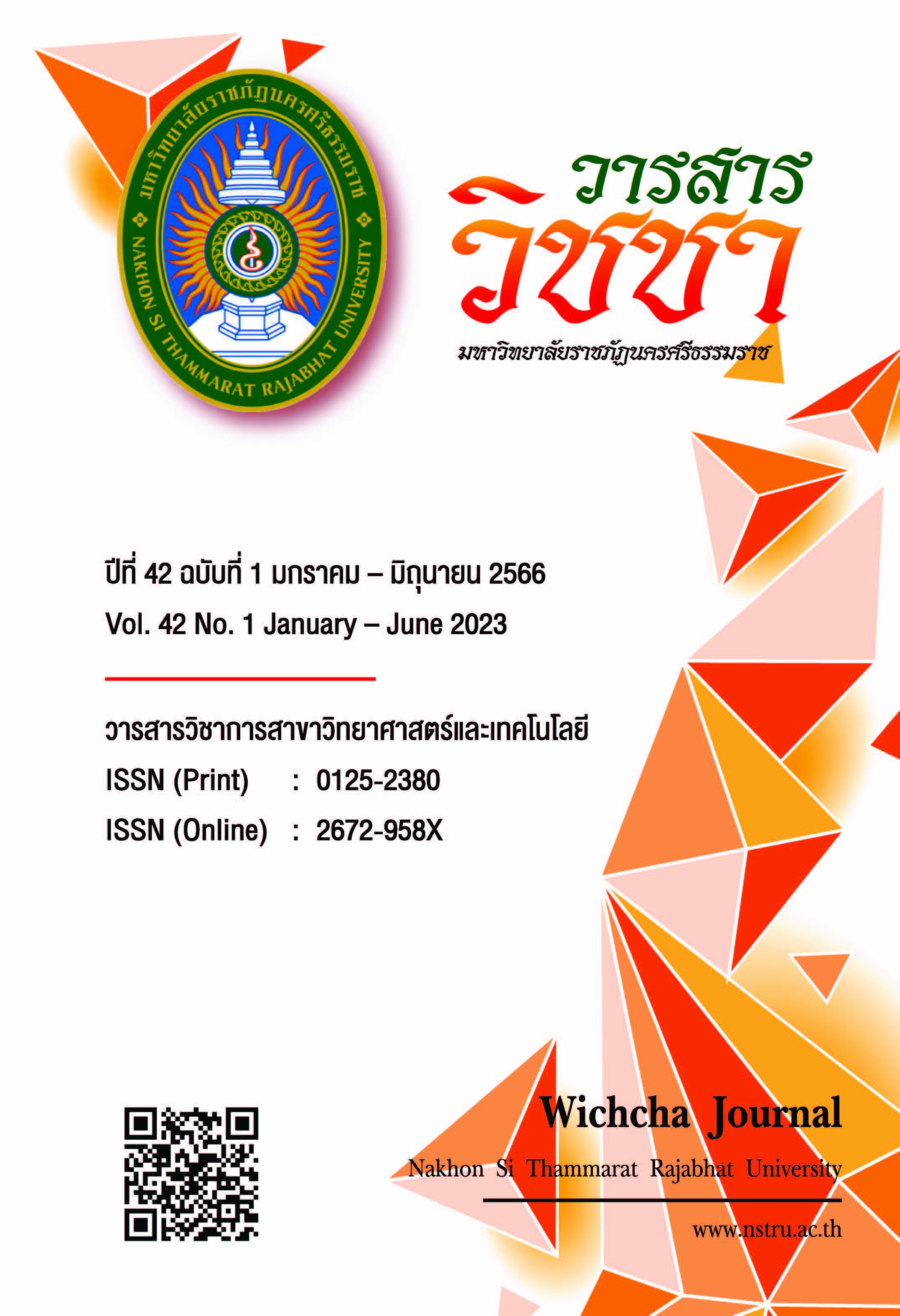The Study on Developmental Biology of Truncate-snouted Burrowing Frog (Glyphoglossus molossus Günther, 1869) for Rearing System Model
Main Article Content
Abstract
The truncate-snouted burrowing frog (Glyphoglossus molossus Günther, 1869) plays an important role in the ecosystem and food source for humans. However, their number is decreasing due to over-harvest and severe habitat loss. However, the biological report of this animal species has been little known. The aims of this research were to study the developmental biology of the embryo, tadpole, and froglet stages. The obtained data from this research were needed for rearing this animal under the simulated natural condition and applying it as an economic animal. The results showed that adult male and female breeding could be accomplished in captivity. Embryo development followed the normal process of amphibian development. Embryo developed and hatched from the membrane into the tadpole stage within 24 hours after fertilization. The truncate-snouted burrowing frog tadpoles showed unique colors and shape. They took about 25-30 days to develop into a froglet stage. The early froglets were approximately 1 centimeter long. The skin was dark brown with individual unique light brown stripes on their bodies. The body weight mean of 100 individuals was 0.19 grams and increased to 4.14, 11.10, 22.00 and 23.62 grams at 45, 90, 135 and 180 days of age, representing a statistically significant difference in weight gain (p < 0.05). The study could be further applied in rearing the truncate-snouted burrowing frog for consumption or commercial uses.
Article Details

This work is licensed under a Creative Commons Attribution-NonCommercial-NoDerivatives 4.0 International License.
เนื้อหาและข้อมูลในบทความที่ลงตีพิมพ์ในวารสารวิชชา มหาวิทยาลัยราชภัฏนครศรีธรรมราช ถือเป็นข้อคิดเห็นและความรับผิดชอบของผู้เขียนบทความโดยตรง ซึ่งกองบรรณาธิการวารสารไม่จำเป็นต้องเห็นด้วยหรือร่วมรับผิดชอบใด ๆ
บทความ ข้อมูล เนื้อหา รูปภาพ ฯลฯ ที่ได้รับการตีพิมพ์ในวารสารวิชชา มหาวิทยาลัยราชภัฏนครศรีธรรมราช ถือเป็นลิขสิทธ์ของวารสารวิชชา มหาวิทยาลัยราชภัฏนครศรีธรรมราช หากบุคคลหรือหน่วยงานใดต้องการนำข้อมูลทั้งหมดหรือส่วนหนึ่งส่วนใดไปเผยแพร่ต่อหรือเพื่อการกระทำการใด ๆ จะต้องได้รับอนุญาตเป็นลายลักษณ์อักษรจากวารสารวิชชา มหาวิทยาลัยราชภัฏนครศรีธรรมราชก่อนเท่านั้น
The content and information in the article published in Wichcha journal Nakhon Si Thammarat Rajabhat University, It is the opinion and responsibility of the author of the article. The editorial journals do not need to agree. Or share any responsibility.
References
กฤษฎา ดีอินทร์ และสุพัฒน์ พลซา. (2563). การปรับปรุงฮอร์โมนอัดแท่งคอเลสเตอรอล สำหรับการเพาะพันธุ์ปลา. วารสารวิทยาศาสตร์เกษตร, 51(1), 138-143.
โกมุท อุ่นศรีส่ง ประสาน พรโสภิณ อุมาภรณ์ จรดล และสมพร กันธิยะวงศ์. (2548). การศึกษาเพาะพันธุ์และพัฒนาการคัพภะเขียดแลว. รายงานวิจัย. กรมประมง.
ขจรเกียรติ์ ศรีนวลสม ชนัญญา พุทธิปิลันธน์ ชอบธรรม บัวลอย และรักพงษ์ เพชรคำ. (2562). ระดับความเข้มข้นที่เหมาะสมและความถี่ในการฉีดฮอร์โมน buserelin acetate ต่อการพัฒนาไข่ของแม่พันธุ์ปลาไหลนา (Monopterus albus) ในช่วงก่อนฤดูผสมพันธุ์. วารสารวิทยาศาสตร์คชสาส์น, 41(2), 57-73.
จุรีรัตน์ ประสาร. (2551). Camouflage ศาสตร์แห่งการอำพรางตัว. วารสารเทคโนโลยีวัสดุ, 53, 59-62.
ชฎาพร โพคัยสวรรค์ และนภธีรา จวอรรถ. (2565). ปัจจัยที่ส่งผลต่อการเลี้ยงกุ้งก้ามกรามบางแพให้มีคุณลักษณะที่เป็นอัตลักษณ์เฉพาะพื้นที่. วารสารวิชชา มหาวิทยาลัยราชภัฏนครศรีธรรมราช, 41(2), 16-27.
ธเนศ นนท์ศรีราช. (2562). ความหลากหลายทางพันธุกรรม โครงสร้างทางพันธุกรรม และความแปรผันทางสัณฐานวิทยาของอึ่งปากขวด (Glyphoglossus molossus) ในภาคตะวันออกเฉียงเหนือของประเทศไทย. ปริญญาวิทยาศาสตรมหาบัณฑิต (ชีววิทยา). มหาวิทยาลัยมหาสารคาม, มหาสารคาม.
นวพรรษ ทวีบท และณภาภัช ไชยน้ำอ้อม. (2558). ความหลากชนิดของสัตว์สะเทินน้ำสะเทินบก และการใช้ประโยชน์ในบริเวณป่าโคกข่าว อําเภอชื่นชม จังหวัดมหาสารคาม. รายงานวิจัย. มหาวิทยาลัยราชภัฏมหาสารคาม.
พนมเทียน นาควิจิตร. (2554). การเพาะพันธุ์อึ่งเพ้า. รายงานวิจัยเอกสารฉบับที่ 36/2554. กรมประมง.
ยุทธนา เอียดน้อย และอมรรัตน์ ถนนแก้ว. (2555). ผลของการพรีทรีทเม้นท์ต่อสมบัติทางเคมี-กายภาพของผลิตภัณฑ์ปลาดุกร้า. วารสารมหาวิทยาลัยทักษิณ, 15(3), 33-38.
สิริฉัตร สุนทรวิภาค พงษ์พันธ์ สุนทรวิภาต อภิชาต เต็มวิชชาการ และประจวบ สายบุ. (2555). การเพาะและอนุบาลอึ่งปากขวด. วารสารวิจัยเทคโนโลยีการประมง, 6(2), 12-22.
สุริยะ จันทร์แก้ว. (2554). ชีววิทยาการเพาะขยายพันธุ์ปลาซิวควายแถบดำ. วารสารวิชชา มหาวิทยาลัยราชภัฏนครศรีธรรมราช, 30(1), 145-152.
Altig, R., and Rowley, J.L.L. (2014). The breeding behavior of Glyphoglossus molossus and the tadpoles of Glyphoglossus molossus and Calluella guttulata (Microhylidae). Zootaxa, 3811(3), 381-386, doi: https://doi.org/10.11646/zootaxa.3811.3.9.
Behr, N. and Rödder, D. (2018). Larval development stages and husbandry of the rice frog Microhyla mukhlesuri Hasan et al., 2014 (Anura: Microhylidae). Bonn zoological Bulletin, 67(2), 109-116, doi: https://doi.org/10.20363/BZB2018.67.2.109.
Bohun, C.S. and Breward, C. (2009). Yolk dynamics in amphibian embryos. Mathematics-in-Industry Case Studies Journal, 1, 99-119.
del Pino, E.M., Venegas-Ferrın, M., Romero-Carvajal, A., Montenegro-Larrea, P., Saenz-Ponce, N., Moya, I.M., Alarcon, I., Sudou, N., Yamamoto, S., and Taira, M. (2007). A comparative analysis of frog early development. Proceedings of the National Academy of Sciences, 104(29), 11882-11888, doi: https://doi.org/10.1073/pnas.070509210.
del Pino, E.M., Avilia, M.U., Perez, O.D., Bennitez, M.S., Alarcon, I., Noboa, V. and Moya, I.M. (2004). Development of the dendrobatid frog Colostethus machalilla. The International Journal of Developmental Biology, 48(7), 663-670, doi: https://doi.org/10.1387/ijdb.041861ed.
Duncan, D.W. (1955). Multiple-range and multiple f-test. Biometrics, 11(1), 1-42, doi: https://doi.org/10.2307/3001478.
Goldstein, J.A., Hoff, K.V.S. and Hillyard, S.D. (2017). The effect of temperature on development and behaviour of relict leopard frog tadpoles. Conservation Physiology, 5(1), 1-8, doi: https://doi.org/10.1093/conphys/cow075.
Kuroshima, S. and Tominaga, A. (2021). Normal development of an aquatic spawning tree frog, Buergeria japonica (Amphibia: Rhacophoridae). Current Herpetology, 40(2), 169-181, doi: https://doi.org/10.5358/hsj.40.169.
Laojumpon, C., Suteethorn, S. and Lauprasert K. (2012). Morphological variation of truncate-snouted burrowing frog (Glyphoglossus molossus) of Thailand. In the 4th Science Research Conference (pp. 56-61). Phitsanulok: Naresuan University.
Maciel, T.A. and Juncá, F.A. (2009). Effects of temperature and volume of water on the growth and development of tadpoles of Pleurodema diplolister and Rhinella granulosa (Amphibia: Anura). Zoologia, 26(3), 413-418, doi: https://doi.org/10.1590/S1984-46702009000300005.
Manzano, A.S., Abdala, V. and Herrel, A. (2008). Morphology and function of the forelimb in arboreal frogs: Specializations for grasping ability?. Journal of Anatomy, 213(3), 296-307, doi: https://doi.org/10.1111/j.1469-7580.2008.00929.x.
Nonsrirach, T. and Lauprasert, K. (2019). Preliminary report on the genetic structure of Glyphoglossus molossus (Anura: Microhylidae) from the Khorat Plateau, North-Eastern Thailand. Journal of Natural History, 53(13-14), 849-861, doi: https://doi.org/10.1080/00222933.2019.1618940.
Sayim, F. and Kaya, U. (2008). Embryonic development of the tree frog, Hyla arborea. Biologia, 63(4), 588-593, doi: https://doi.org/10.2478/s11756-008-0086-z.
Serrano, A.E. and Poku, G. (2014). Nutritive value of termite as fish meal supplement in the diet of freshwater prawns (Macrobrachium rosenbergii de Man) juveniles. Extreme Life, Biospeology & Astrobiology International Journal of the Bioflux Society, 6(2), 63-71.
Sretarugsa, P., Luangborisut, P., Kruatrachue, M., and Upatham, S. (1997). Effects of diets with various protein concentrations on growth, survival and metamorphosis of Rana tigerina and R. catesbeiana. Journal of the Science Society of Thailand, 23, 209-224.
The International Union for Conservation of Nature. (2022). The IUCN red list of threatened speciesTM. Retrieved 5 November 2022, from: https://www.iucnredlist.org/search?query=Glyphoglossus%20molossus%20&searchType=species.
Traijitt, T., Kitana, N., Khonsue, W. and Kitana, J. (2021). Chronological changes in the somatic development of Hoplobatrachus rugulosus (Wiegmann, 1834) (Anura: Dicroglossidae). Tropical Natural History, 21(1), 184-199.
Xiong, R.C., Jiang J.P., Fei, L., Wang, B. and Ye, C.Y. (2010). Embryonic development of the concave-eared torrent frog with its significance on taxonomy. Zoological Research, 31(5), 490-498, doi: https://doi.org/10.3724/SP.J.1141.2010.05490.


